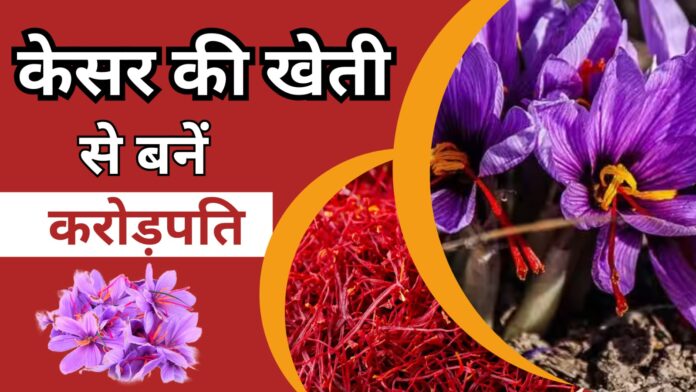Saffron, often called “red gold,” has long been prized for its aromatic, culinary, and medicinal value. But how exactly did saffron farming elevate some farmers into millionaires? To fully understand the transformation, we need to delve into the history, cultivation techniques, market dynamics, and potential of saffron as a lucrative crop.
The History of Saffron Farming
Saffron has a rich and ancient history that dates back over 3,000 years, originating from the Mediterranean region. Traditionally grown in countries like Iran, Greece, and Kashmir, saffron has held an essential place in trade and culture due to its distinct properties. Its labor-intensive cultivation process and limited growing regions make saffron one of the most expensive spices in the world.
Understanding the Cultivation Process of Saffron
1. Saffron’s Unique Growth Conditions
Saffron is derived from the stigmas of the Crocus sativus flower, which blooms only for a few weeks each year. The crocus thrives in well-drained soils with mild winters and dry summers. Climate conditions are crucial to its successful growth, which is why saffron is cultivated in specific regions such as Iran, Kashmir, Spain, and parts of Europe.
One of the reasons saffron is so valuable is because of the labor-intensive harvesting process. Each flower produces only three stigmas, and 150,000 flowers are required to produce just one kilogram of saffron. The stigmas are harvested by hand and must be dried quickly to retain their delicate flavor and color.
2. Labor and Harvesting Techniques
Harvesting saffron is no easy task. Farmers wake at dawn to collect the flowers as soon as they bloom, a task that requires precision and speed. The short harvesting window — about 4-6 weeks — makes this a demanding endeavor. After harvesting, the stigmas must be dried and packaged in a manner that preserves their potency and quality.
What sets saffron apart from other crops is that it is purely organic, requiring little to no chemical fertilizers or pesticides, adding to its market value and consumer demand.
The Economics of Saffron Farming
1. High Market Demand and Limited Supply
Saffron’s exclusivity is one of its greatest economic advantages. With high demand in the culinary, pharmaceutical, and cosmetics industries, the market value of saffron has continued to rise. Countries like Iran dominate the global saffron production, with over 90% of the world’s supply coming from its fields. This limited supply has led to prices as high as $3,000 to $10,000 per kilogram, depending on quality and origin.
2. Rising Global Interest in Organic and Specialty Foods
Over the past decade, the global market has seen an increased interest in organic and specialty foods, particularly spices that offer health benefits. Saffron is renowned for its medicinal properties, including acting as an antidepressant, antioxidant, and digestive aid. This rise in awareness has led to more consumers demanding high-quality, authentic saffron, pushing prices even higher.
3. Government and Institutional Support
In regions like Kashmir, the local government has launched initiatives to promote saffron cultivation. Subsidies, improved irrigation systems, and export promotion programs have encouraged farmers to adopt saffron farming, boosting their productivity and profitability.
How Saffron Farming is Creating Millionaires
1. Low Initial Investment, High Return
Saffron farming requires relatively low initial investments compared to other high-value crops. Crocus sativus bulbs are inexpensive, and the maintenance costs are minimal. Once established, a saffron farm can continue producing for up to 15 years, making it a long-term, profitable investment.
2. International Export Opportunities
Saffron farmers who have embraced modern export strategies have seen substantial financial returns. E-commerce platforms and direct-to-consumer models allow small farmers to sell saffron globally, bypassing traditional middlemen and receiving higher profit margins. The demand from international buyers, especially in countries like Japan, the United States, and European nations, has significantly boosted the incomes of many saffron farmers.
3. Innovation in Saffron Products
Some farmers have diversified their saffron products, moving beyond selling it as a raw spice. By producing saffron-infused teas, oils, and skincare products, farmers are tapping into luxury markets. This diversification enables them to increase their profit margins and target niche consumers willing to pay premium prices for saffron-based products.
Challenges and Opportunities for Aspiring Saffron Farmers
1. Climate Dependency
One of the biggest challenges for saffron farmers is the dependence on specific climate conditions. A slight fluctuation in temperature or unexpected rainfall can drastically affect the quality and yield of the crop. However, some innovative farmers are adopting greenhouse farming techniques to control environmental variables and ensure consistent yields.
2. Counterfeit Saffron
The global saffron market is plagued by counterfeit products, which are often mixed with other materials to increase weight. This not only deceives consumers but also threatens the profitability of genuine saffron farmers. To counter this, several initiatives have been introduced to certify and trace the origin of authentic saffron, ensuring that farmers who produce high-quality products can command higher prices.
3. Potential for Technological Advancements
With advancements in agriculture technology, such as drip irrigation systems and AI-based monitoring, saffron farming is becoming more efficient. These technologies help farmers optimize water usage, monitor soil health, and forecast yield potentials, leading to better crop management and increased profits.
Conclusion
The journey of saffron farming from humble beginnings to creating millionaire farmers is nothing short of fascinating. By combining ancient techniques with modern innovations, saffron farmers have unlocked the full potential of this red gold. As global demand for saffron continues to rise and more farmers enter the market, the future looks bright for those who master the delicate art of saffron cultivation.
